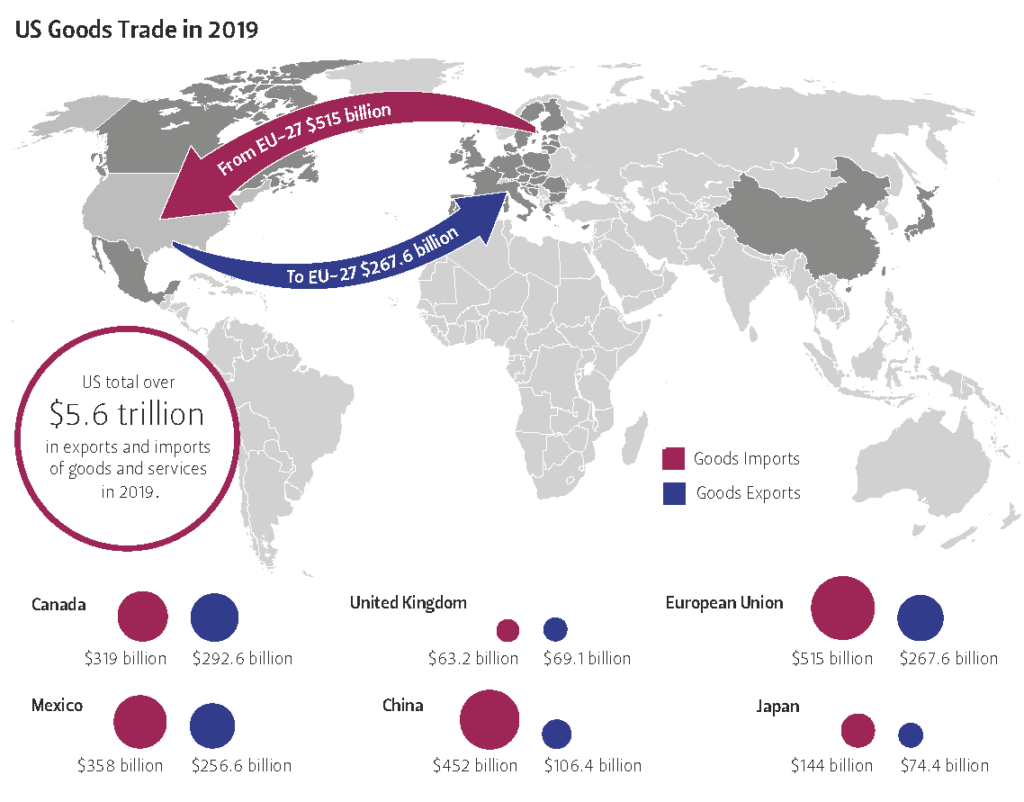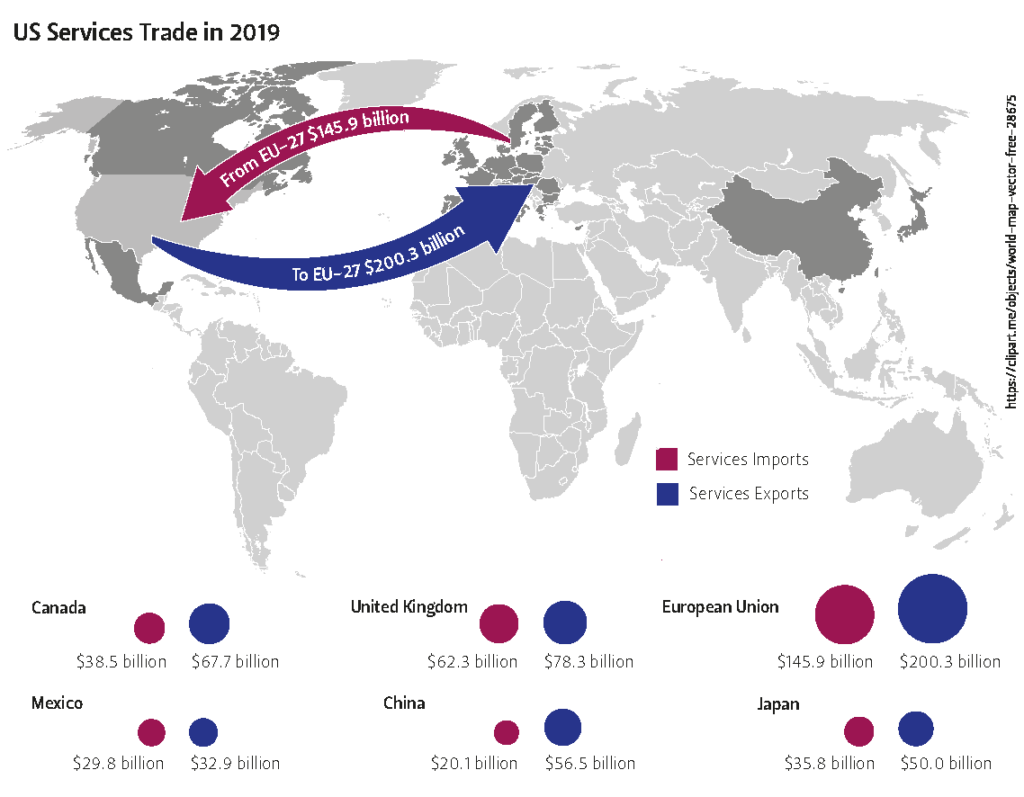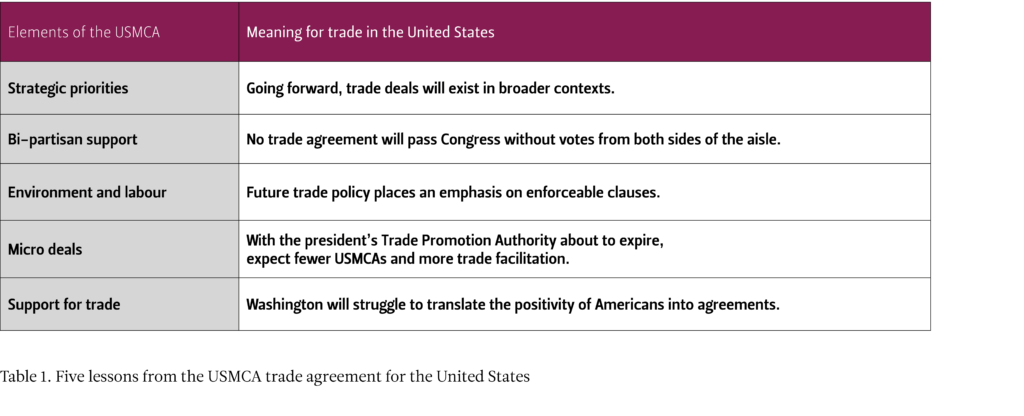yhteenveto
- Yhdysvallat on siirtynyt kauppapolitiikassaan kaupan yhdentymisen johtavasta puolustajasta sen äänekkääksi kriitikoksi. Joe Biden muuttaa kauppapolitiikan sävyä mutta ei sisältöä. Uusi hallinto lisää maahan markkinoillepääsyn esteitä.
- Poliittisesta kehityksestä huolimatta Yhdysvaltain kansalaiset suhtautuvat kauppaan entistä positiivisemmin. Odotuksia vastaavien kauppasopimusten solmiminen on kuitenkin haastavaa. Eurooppalaisten ajamat digitaaliset verot pahentavat tilannetta entisestään, sillä Yhdysvalloissa verot tulkitaan tulleiksi.
- Yhdysvaltojen kongressin myöntämä presidentin kaupan edistämisoikeus (TPA) on raukeamassa kesällä, ja kongressi on ollut haluton määrittelemään uusia kriteerejä TPA:lle. Washington ei vaikuta olevan valmis osallistumaan merkittäviin kauppaneuvotteluihin lähitulevaisuudessa. Kun Yhdysvallat kokee tarvetta uusille kauppasopimuksille, ne liittyvät todennäköisesti johonkin laajempaan strategiseen projektiin.
- Sääntöpohjainen kauppa tarvitsee uusia johtajia. Muiden on taivuteltava Yhdysvallat mukaan sopimuksiin, kun siihen löytyy yhteisiä intressejä.
Introduction
“What worries me most, however, is the fact that the rules-based international order is being challenged. Quite surprisingly, not by the usual suspects, but by its main architect and guarantor: the US.” Thus spoke Donald Tusk, the President of the European Council in advance of the G7 Summit of 2018.[1] In doing so, he was echoing the sentiments of many others.
Sabre-rattling at friends and foes alike defined the Trump administration’s approach to trade policy, not unlike in many other policy fields. It also demonstrated Donald Trump’s preference for bilateral agreements, the most prominent of which was the so-called Phase One deal with China. Trade policy was a definite priority for the Trump administration, but it took some self-contradictory forms. Often Trump wanted to wreak havoc for its own sake, which both held back part of his “negative agenda”, such as confronting China, and the “positive” one of bilateral mini deals, as in the late 2020 trade-smoothing with Brazil.
By contrast, trade has not been a priority for either the Biden administration or the 117th Congress thus far.[2] There is little sign that President Biden would either immediately roll back Trump-era tariffs and reclassifications – much less sanctions – or initiate his own positive trade agenda. This lack of initiative stands in contrast to rapid executive action on climate, Covid-19, US manufacturing and other policy priorities. Congress, too, has been conspicuously silent on trade. With organized labour a resurgent force within Democratic Party politics, any talk of new trade deals over assistance for the deindustrialized homeland will face some headwind.
The silence around trade suggests that while Biden will attempt to smooth over the worst rows over commerce, the easiest course for his administration is, by and large, to underwrite a policy shift on trade. The rest of the world must come to terms with this change, but also formulate cogent responses to it.
The stakes are high because a functioning and flexible trading system is essential for tackling the greatest challenges of our time, including the fight against climate change and the production of vaccines against COVID-19. Instead of turning against international cooperation, these and many other priorities need to be integrated into the global trading system. First and foremost, the world needs a proudly pragmatic approach, in place of a “summit for democracy” or any such high-minded initiative which runs the risk of preventing partnerships and ringing hollow. An alliance of democracies may be the outcome of cooperation but should not be positioned as its prerequisite.
At the end of World War I, the United States fathered the Covenant of the League of Nations but rejected it at birth; Washington withheld its recognition of the child, never joining the League. The United States received a second chance at the end of the World War, founding the United Nations and the Bretton Woods institutions, and a third one at the end of the Cold War when the World Trade Organization came to supersede the General Agreement on Tariffs and Trade (GATT). Now, America is edging closer to rejection, again.
The main argument of this Briefing Paper is that not only has US governmental policy on trade shifted, but also that the environment in which it is developed has altered radically – not least due to US policy itself. This means that, one, rules-based trading will need new champions and, two, others must coax the United States to come along when they can find shared reasons for doing so.
The paper looks at both the worlds that the US chose to mould and the ones that it rejected: the USMCA and the TPP. It also asks how Europeans might orient themselves in the direction of the United States, examines what trade without deals may mean and, finally, situates current policy in the longer trajectory of the US role on trade.


Trade of US goods and services in 2019. Source: https://ustr.gov/countries-regions
THE WORLD THAT WAS NOT – THE REJECTION OF THE TPP
Transitions of power in Washington are known for clear shifts, but few about-faces have been as drastic and potentially enduring as that on trade policy on 23 January 2017. That is when Donald Trump scrapped the Trans-Pacific Partnership (TPP), an agreement Barack Obama and eleven other leaders had signed just a little over a year earlier. The stranded TPP-11 were determined to rescue what they could from Trump’s wreckage. The salvage took the form of the CPTPP or the Comprehensive and Progressive Agreement for Trans-Pacific Partnership for the remaining countries.
Even with only seven ratifiers – Australia, New Zealand, Singapore, Vietnam, Japan, Canada and Mexico – the CPTPP remains substantive. It is also a curious thing, as for years it was the holy grail of US trade negotiators yet, now, also remains out of their grasp. The transoceanic agreement and the world’s largest free-trade agreement was supposed to be not only the foundation of the New American Century in the Pacific but also of global trade at large, with a membership of 40 per cent of the world economy.
The only comparison that captures the magnitude of Washington’s reversal, or betrayal, is from a century earlier, when the US Senate rejected the Treaty of Versailles and thereby also Woodrow Wilson’s brainchild, the League of Nations. This time around, the United States moved to hinder the global trading system it had spent decades building. In another sign, the Trump administration blocked new appointments to the World Trade Organization’s Appellate Body, halting the dispute settlement upon which trade rules rest.
The US strategic position has altered, exemplified by China and 14 other Asian countries – including CPTPP participants – forming in late 2020 the Regional Comprehensive Economic Partnership (RCEP). Above all, the RCEP will allow China to draw its own trade and supply patterns. The TPP always had a strong element of providing a counterweight and alternative to Chinese economic linkages, precisely the kind that the RCEP seeks to form and reinforce.
In the Biden era, many expert voices are calling for Washington to get back in the game. Executive Vice President Marcus Noland of the Peterson Institute for International Economics (PIIE), among others, has argued that the US should go ahead and join the CPTPP, which with diminished investor-state dispute settlement measures should be more acceptable to congressional Democrats than the TPP.[3] In fact, as Noland suggests, it is more akin to the United States-Mexico-Canada agreement, the renegotiated regional trade deal that passed with strong bipartisan support. It was also the most important element on the positive trade agenda of the Trump presidency.
THE WORLD THAT WAS – FIVE LESSONS FROM THE USMCA TRADE AGREEMENT
Just like the original US agreement with Canada in 1989 and the original NAFTA, North American Free Trade Agreement, that superseded it in 1994, the USMCA also looks to carry several lessons forward. The USMCA serves as the blueprint for future US trade agreements, especially in its emphasis on labour and the environment, in addition to the more limited, smaller deals in the works around the world.
The reasons for ratifying the “New NAFTA” in early 2020 included several elements, which help explain why this specific agreement was reached. They also provide lessons beyond North America, just as the original NAFTA provided impetus for other future trade advances, including the formation of the World Trade Organization a year later in 1995.
The first lesson of the USMCA was the importance of external factors, particularly the securing of trade routes in America’s “near abroad” at a time of trade war with China. Possible Chinese encroachment into either Mexico or Canada – even through its 5G networks – is unacceptable to Washington. Going forward, when the US sees the need for a deal, it is likely to be associated with a broader strategic project. This is the first element that one should expect to carry forward in US trade policy.
The second lesson is an internal one: Bi-partisan support is vital for trade agreements. In the run-up to the November 2020 general election, President Trump and House Democrats were fighting over who got to claim credit for the USMCA. Trump laid claim to having obtained a better deal for the United States, while Democrats paraded the environmental clauses that they had included in the agreement and, especially, the aggressive monitoring of Mexican labour practices. The inclusion of enforceable labour and, increasingly, climate and other environmental clauses is the third lesson to expect from future trade policy.
While Trump had a clear preference for bilateral deals, President Biden will, at least, speak the language of multilateralism. However, as his Trade Promotion Authority is set to expire this summer, Biden’s ability to strike larger, multilateral deals would be severely hampered. The fourth element in US trade policy is therefore expected to be “micro deals”, such as the trade-smoothing agreement that was concluded with Brazil in 2020. Even the economic impact of a USMCA, a deal negotiated under the TPA and ratified by Congress, is minor. Together, this should signal some form of agreement with Kenya, which is already in the works, but few should hold their breath for a comprehensive agreement with the United Kingdom. For that to happen, the TPA would have to be renewed.
The fifth and final ingredient that was essential for the passing of the USMCA was public support. Despite all the talk about trade scepticism, Gallup has tracked a near constant rise in positive perceptions of trade amongst the US public ever since 2012.[4] Even if the share of Americans who believe that foreign trade is “an opportunity for economic growth through increased U.S. exports” were to fall from the nearly eight in ten respondents, it is unlikely to fall under half of the country any time soon. This broad public support for trade is the fifth element that looks highly likely to continue deep into Biden’s term in office, even if leaders in Washington will struggle to translate that positivity into an agenda that will not have its champions pushed out of office.

TRANSATLANTIC RELATIONS’ STUMBLING, BUILDING AND TRIANGULAR BLOCKS
While North America was Trump’s focus and even Obama prioritized Asia-Pacific over Europe, the Old Continent is re-emerging on the Biden agenda. The new, or newly pressing, reasons for this are threefold: digital trade, climate policy, and China.
In the aftermath of the EU’s General Data Protection Regulation GDPR, Washington is worried about European digital policy, especially its many moves to tax US Big Tech companies, with the United States Trade Representative having multiple investigations underway on Europe’s digital taxes. Digital trade is increasingly the leading American priority in all geographies; something Europeans and others must appreciate. If Brussels were to seek a broad agreement with Washington over digital trade, it might even be able to push for a settlement in other disputes such as those over aviation or steel.
America’s own internal divisions on Big Tech and investigations regarding their use of monopoly power mean that Washington’s sympathy in their direction is limited. That said, US politics still tends to stop at the water’s edge; Trump attacked social media companies at home and defended them abroad. This needs to be kept in mind in any discussion of transatlantic trade.
Europeans must recognize that hitting the US hard in this arena can blow up European ambitions of having a closer working relationship with Washington. In recent years, the defence of Big Tech interests has emerged as not only industrial policy in disguise, but also as a broader foreign policy objective. In Washington, Europe’s digital taxes are considered tariffs plain and simple, a position the Biden administration looks unlikely to reverse. This makes digital trade the stumbling block in EU-US relations.
The building block for closer transatlantic cooperation is climate policy. Unlike during the Trump administration, the remoulding of both the European and American economies is a deeply held objective on both sides of the Atlantic. Domestically, Biden has started a conversation on a carbon tax, and proposals regularly include some form of carbon adjustment at the border, which is something that Biden spoke about even while on the campaign trail. In March 2021, the carbon tax and adjustment proposals were reiterated in the United States Trade Representative’s announcement of the president’s 2021 Trade Policy Agenda.[5]
Meanwhile, the EU is devising its own carbon levy this year, also as a form of industrial policy. But it need not be just about industry, as exemplified by a proposal from Germany’s Greens that carbon policy should re-anchor the entire transatlantic alliance.
A word of caution is necessary. While climate policy may present a once-in-a-generation opportunity for Brussels and Washington to find a common cause, they must work in lockstep. If not, they may trigger a trade war unlike any we have seen in generations, over the pricing of carbon at their respective borders.
The final block is a triangular one with Washington, Brussels and Beijing occupying different corners of its base. If half a century ago, Henry Kissinger was working to peel off China from the Soviet sphere of influence, this time it is China attempting to divide the United States and Europe. As it stands, Beijing is busy steepening the slope of the hill it must climb with its policies in Hong Kong and Xinjiang, deterring many Europeans who instinctively might not fall in line with US priorities on other issues such as the sourcing of 5G technology.
However, it is too early to say which corner of the triangle will win the day and connect two of the three capitals. Against the backdrop of Covid-19, China has failed to purchase sufficient imports from the United States to keep its side of the Phase One deal. While the Biden administration is “reviewing” China policy, there is little reason to believe this would mean unilateral surrender in the trade war launched by its predecessor. Just like the support for the USMCA, remaining tough on China is one of the few things Democrats and Republicans as well as independents agree upon.
For the first time in 2020, China has emerged as the European Union’s largest trading partner in goods, surpassing the United States. To make matters worse for Washington, Brussels and Beijing sealed their Comprehensive Agreement on Investment (CAI) in late December 2020, with many in Washington taking the agreement as a slight in the direction of the incoming Biden administration. Experts in finance and trade have highlighted Europe’s increasing irrelevance in the rest of Asia with too much emphasis being put on the People’s Republic of China. Washingtonians have a tough time grasping why Europeans would want to position themselves as Beijing’s junior partners.
Washington and Beijing as well as Brussels and Beijing have ongoing processes for improving trade and investment relations; Brussels and Washington do not. They must learn to work together if they want to hang together in Beijing and beyond; for this to happen, it is not only Europe that must exercise care in formulating its policies. American navigators must chart an Atlantic future that does not first require a crossing of the Pacific; Europe, too, deserves Washington’s attention.
GLOBAL TRADE WITHOUT DEALS AND DESPITE ORDERS
What might be a realistic expectation for Washington’s outlook on trade? Europeans and others should brace for no new deals, but trade will not stall. It is even possible that to extend his Trade Promotion Authority, set to expire on 1 July 2021, Biden will not speak of any new deals in advance. If the TPA is extended, and once Biden is a half year into his presidency, he might be better placed to begin to formulate what, in his words, a “sustainable global economic recovery” might look like.[6]
The crucial aspect to understand is that while the US public is bullish on trade itself, it associates new agreements with the kind of deindustrialization that, for example, the Midwest has undergone. This is a paradox with which both Washington and America’s allies must live. Former US Treasury Secretary Larry Summers has called his successor (and presumably other leadership) to acknowledge that international economic policies are not “acts of charity to other countries or service to American elites but are direct contributors to raising the incomes of middle-income families”.[7] This is the general thrust of Biden’s “Build Back Better” and “Foreign Policy for the Middle Class” agendas as well – both of which require aligned trade policy.
A domestic trade agenda with an emphasis on investments in the United States is a risk for both US trading partners and Americans. A China policy that is lopsidedly domestic, focusing on things such as America’s own democracy and technology, risks succumbing to nonsense. Ultimately, a US foreign or trade policy towards China must be about China. Whatever the exigencies of the moment may be, the United States can focus on its home turf for only so long. Either it engages with the outside world on terms it sets itself or those set by others.
America’s trading partners in North America, Europe and elsewhere also have immediate issues to tackle. In February, Biden ordered a 100-day review of US supply-chain resilience with an emphasis on domestic production and the supply of semiconductors, batteries, and minerals. Biden’s January 2021 update on the federal government’s public procurements highlighted the administration’s Buy American focus. His Executive Order on Ensuring the Future Is Made in All of America by All of America’s Workers strengthens the “component test”, increasing the thresholds at which a product can be considered domestic. Even before its full implementation, US partners, including Canada, which sends three quarters of its exports south of the border, should assume an increasingly tilted playing field.
The growing reliance on not only domestic actions but also bilateral initiatives to make trade policy is a sign of US weakness in the global field. The standstill at the World Trade Organization is about the US interest in treating China like a peer competitor and Beijing’s unwillingness to relinquish its preferred status as a (still) developing economy. The world trading system has faltered because the US has not been able to bend China to its will.[8] Then again, China has also turned out to be a lukewarm – if not irresponsible – stakeholder in the trading system that allowed it, at a stupendous pace, to rise out of poverty into power.
After Trump’s opposition, the appointment of Ngozi Okonjo-Iweala as the new Director-General of the WTO underlines how Biden wants to give the international body another try. Foreign interlocutors have taken note of US suspicion towards the body and even hostility, including calls from Senator Josh Hawley to abolish the WTO.[9] As such, much of Washington is looking at alternative avenues for standard-setting on trade and political economy more broadly, with the OECD emerging as a leading candidate. Its first test will be to find a way out of the impasse over digital trade by rewriting some rules on global taxation.
CONCLUSION: THE LONG TRAJECTORY UPENDED
Over three decades ago, David A. Lake explained in his classic Power, Protection, and Free Trade how protectionism is too often explained as a result of domestic pressures.[10] In this line of thinking, trade would be free if it were not for those meddling interest groups and, in some cases, even legislatures. Lake studied the half century before the US became the leader on free trade, while we are living through a moment when it is increasingly questionable whether Washington still wants to hold onto that mantle.
At a moment of retreat rather than opening, the roles of different actors seem reversed. For example, pressure groups such as the US Chamber of Commerce are doing their utmost to keep trade free and, at least at the start of the US-China trade war, the executives of major American corporations were seen standing alongside the Chinese leadership. So much for the old truism that producers have direct interests in protection, while consumers experience its cost more indirectly and globally.
A world of globalized production and consumption has rattled old assumptions and raised two kinds of questions. The first concerns the nature of today’s political economy under a “Clash of Capitalisms”, the rivalry between US and China-led models, and how different actors will play the game of geoeconomics.[11] Not only is it rebounding as a form of even official US government statecraft, namely tariffs and sanctions, it is also transforming the corporate diplomacy of yesteryear into today’s corporate statecraft with companies becoming more central to global strategic competition.[12] Both forms of statecraft are ultimately about defining and pursuing objectives that are often defined more broadly than in the past.
The second kind of question concerns the position of the United States in the world: Is the world’s trading system, or US trade policy merely the first carriage to have become derailed in a much greater train wreck of international affairs?
In addition to assessing all that was destructive in the Trump years, we must also look for the constructive. We must take seriously the “positive” trade agenda of the Trump years – however limited – and assess which elements of it may carry forward. A clear silver lining is that the US public’s view of trade has improved, which was mirrored in broad support for the USMCA, the renegotiated North American trade deal. Whether the emerging consensus is sufficient to have paved the way to a future trade-and-climate pact between Brussels and Washington is a question in search of an answer.
Nothing is predetermined. US partners and allies can and should look for ways to entice Washington and the country that it governs. Most importantly, Americans themselves should see how much they have to lose if they turn their back on the world; that is not all about trade, but it is certainly a big part of the equation.
Endnotes
[1] European Council, Remarks by President Donald Tusk before the G7 summit in Charlevoix, Canada, 8 June 2018, https://www.consilium.europa.eu/en/press/press-releases/2018/06/08/remarks-by-president-donald-tusk-before-the-g7-summit-in-charlevoix-canada/.
[2] Ryan C. Berg, Lauri Tähtinen, & Stan Veuger, ‘Time for Congress to Shape Commerce’, The Bulwark, 25 January 2021, https://thebulwark.com/time-for-congress-to-shape-commerce/.
[3] Marcus Noland, Memo to the Biden administration on how to reinvigorate US alliances, 23 November 2020, https://www.piie.com/blogs/realtime-economic-issues-watch/memo-biden-administration-how-reinvigorate-us-alliances.
[4] Lydia Saad, ‘Americans’ Vanishing Fear of Foreign Trade’, 26 February 2020, https://news.gallup.com/poll/286730/americans-vanishing-fear-foreign-trade.aspx.
[5] 2021 Trade Policy Agenda and 2020 Annual Report of the President of the United States on the Trade Agreements Program, https://ustr.gov/sites/default/files/files/reports/2021/2021%20Trade%20Agenda/Online%20PDF%202021%20Trade%20Policy%20Agenda%20and%202020%20Annual%20Report.pdf
[6] Readout of President Joseph R. Biden, Jr. Call with Chancellor Angela Merkel of Germany, 25 January 2021, https://www.whitehouse.gov/briefing-room/statements-releases/2021/01/25/readout-of-president-joseph-r-biden-jr-call-with-chancellor-angela-merkel-of-germany/.
[7] Lawrence H. Summers, Memo to the Biden administration on priorities for the US Treasury, 10 November 2020,
[8] Kristen Hopewell makes this case particularly powerfully in her recent Clash of Powers: US-China Rivalry in Global Trade Governance (Cambridge: Cambridge University Press, 2020).
[9] Josh Hawley, ‘The W.T.O. Should Be Abolished’, The New York Times, 5 May 2020,
https://www.nytimes.com/2020/05/05/opinion/hawley-abolish-wto-china.html.
[10] David A. Lake, Power, Protection, and Free Trade: International Sources of U.S. Commercial Strategy, 1887–1939 (Ithaca: Cornell University Press, 2018).
[11] Branko Milanovic, ‘The Clash of Capitalisms: The Real Fight for the Global Economy’s Future’, Foreign Affairs, January/February 2020, https://www.foreignaffairs.com/articles/united-states/2019-12-10/clash-capitalisms.
[12] Henrique Choer Moraes & Mikael Wigell, ‘The Emergence of Strategic Capitalism: Geoeconomics, Corporate Statecraft and the Repurposing of the Global Economy’, FIIA Working Paper, 117, September 2020, https://www.fiia.fi/wp-content/uploads/2020/09/wp117_the-emergence-of-strategic-capitalism_final.pdf.

